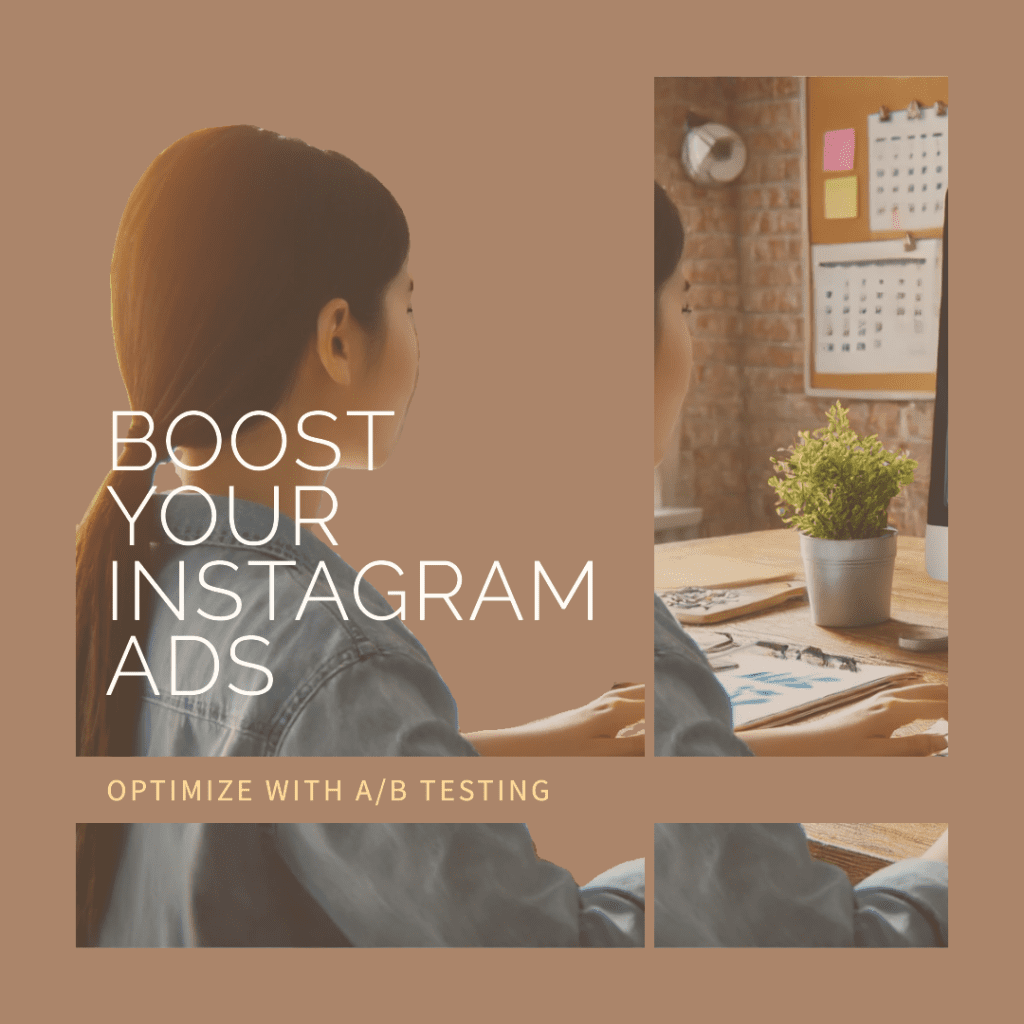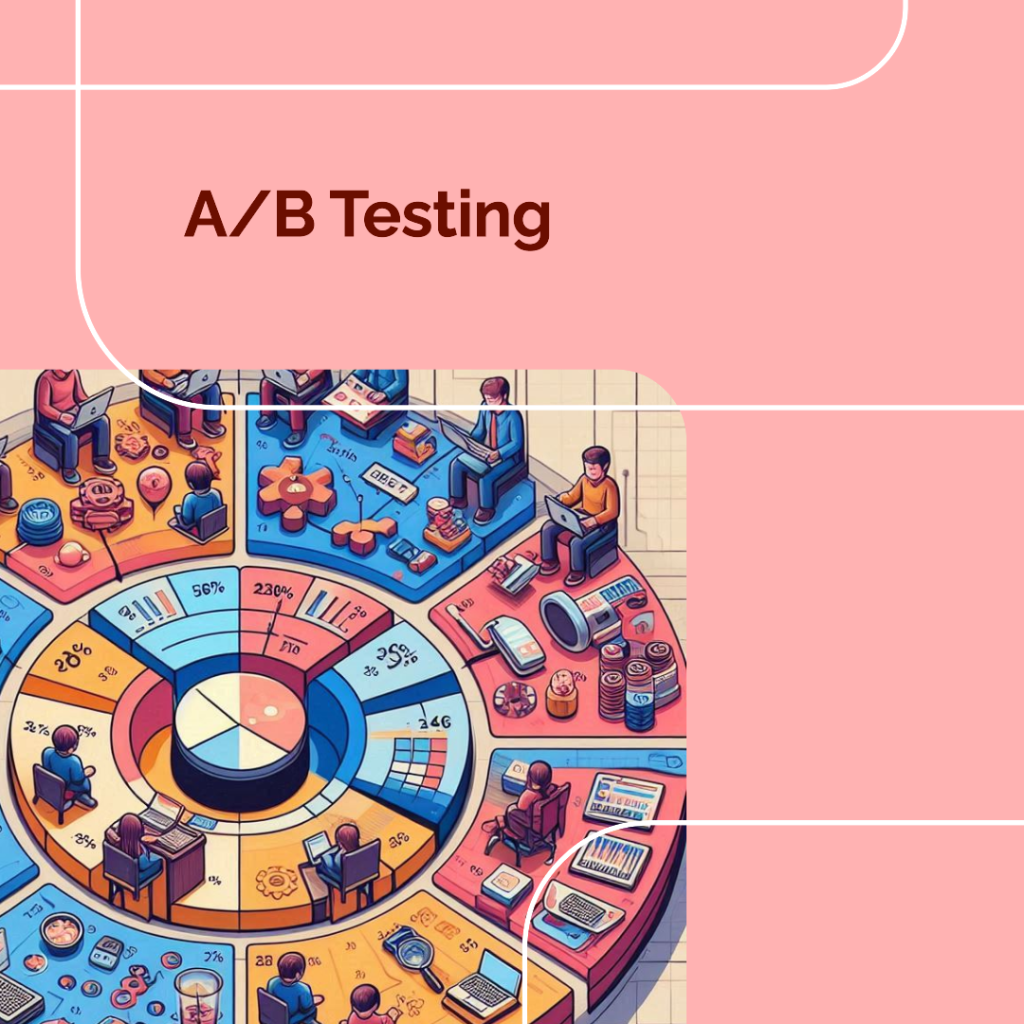Last Updated on June 18, 2024 by Val Razo
A/B testing, also known as split testing, is a powerful tool for marketers looking to optimize their Instagram ad campaigns. By creating two different versions of an ad, you can test different elements to see which one performs better. This process involves dividing your audience into two groups and showing each group a different version of the ad. The goal is to gather insights and data to make informed decisions that enhance your social media strategy.
Running effective Instagram ads requires a deep understanding of your audience and the elements that increase engagement. Through A/B testing, you can experiment with various aspects such as call-to-action (CTA) buttons, ad formats, and creative testing. This method not only helps in identifying the best practices for your campaigns but also plays a crucial role in improving your overall social media marketing efforts.
By leveraging tools like Facebook Ads Manager, you can efficiently set up and manage your A/B tests. These platforms provide the necessary analytics to measure key metrics like engagement rate, cost per conversion, and overall ad performance. Understanding these metrics is essential for optimizing ads and achieving better results.
In this guide, we will explore how to effectively set up and run A/B tests on Instagram, analyze the test results, and implement strategies to optimize your Instagram ads. Whether you’re a seasoned marketer or new to social media marketing, this comprehensive guide will provide valuable insights and practical tips to help you succeed.

Setting Up Your Instagram Ad Campaign for A/B Testing
Preparing Your Campaign
Setting up an effective A/B test for your Instagram ad campaign begins with careful planning and preparation. Start by defining clear objectives for what you want to achieve with your test. These objectives could include increasing conversion rates, improving engagement rates, or determining which ad format works best for your audience. Having specific goals will guide the rest of the testing process.
Next, decide on the different elements you want to test. Common elements to test include CTA buttons, headlines, images, and ad copy. By identifying the elements most likely to impact your ad performance, you can design a test that provides meaningful insights. For instance, if you’re unsure whether a video ad will perform better than a static image, create two versions of the ad featuring these different formats and compare their performance.
After identifying the elements to test, create your test variations. This involves designing two ads (or more, depending on the complexity of your test) that differ only in the element you want to test. For example, if you’re testing different headlines, both ads should have identical images, CTAs, and ad copy, with only the headline being different. This ensures that any difference in performance can be attributed to the headline itself.
Before launching your test, set up tracking and measurement tools. These tools will help you monitor the performance of each ad variation and gather the data needed to determine which ad performs better. Important metrics to track include click-through rate (CTR), conversion rate, and overall engagement. By closely monitoring these metrics, you can gain valuable insights into what works best for your audience and make data-driven decisions to optimize your ad campaign.
When I first started optimizing my Instagram ads, I decided to test different call-to-action (CTA) buttons to see which one would drive more conversions. I created two versions of the same ad: one with a ‘Shop Now’ button and another with a ‘Learn More’ button. After running the ads for a week, I noticed that the ‘Shop Now’ button had a significantly higher click-through rate. This insight helped me understand the importance of having a direct call-to-action in my ads.
How to Split Your Audience Effectively
A critical aspect of A/B testing is ensuring that each version of your ad is shown to a representative sample of your target audience. Proper audience segmentation is key to obtaining reliable and valid results from your A/B test. Using tools like Facebook Ads Manager, you can create audience segments and distribute your ads evenly across these segments.
Start by defining your target audience based on demographics, interests, behaviors, and other relevant criteria. Once your audience is defined, split it into equally sized groups. Each group should be exposed to a different version of your ad. This method, known as split your audience, ensures that the test results are not biased by external factors and that the performance differences can be attributed to the ad variations themselves.
Ensure that the audience groups are as similar as possible in terms of their characteristics. This will help in achieving statistical significance in your results. For example, if you are targeting a specific age range or interest group, make sure that both test groups have a comparable distribution of these characteristics.
By effectively splitting your audience and ensuring proper segmentation, you can gather accurate and actionable data from your A/B tests. This data will help you make informed decisions about which ad variations perform better and how to optimize your Instagram ad campaigns for maximum impact.
Best Practices for Running A/B Tests on Instagram
Testing Best Practices for Optimal Results
Running effective A/B tests on Instagram requires following best practices to ensure reliable and actionable results. Here are some key practices to consider:
- Test One Variable at a Time: To accurately determine the impact of each element, focus on testing one variable at a time. Whether it’s the CTA, headline, image, or ad copy, changing only one element per test will help you understand its specific effect on your ad performance.
- Ensure Adequate Sample Size: For your test to yield meaningful insights, you need a large enough sample size. This means that each version of the ad should be shown to a sufficient number of people to achieve statistical significance. Without an adequate sample size, your results may not be reliable.
- Run Tests for an Appropriate Duration: Running your test for too short a period can lead to inconclusive results while running it for too long can waste resources. Aim to run your A/B tests long enough to gather sufficient data but not so long that it delays decision-making. Typically, a test should run for at least one to two weeks to account for variations in daily behavior.
- Monitor Key Metrics: Track important metrics such as click-through rate (CTR), conversion rate, and engagement rate. These metrics will provide insights into how each ad variation performs and help you identify which elements contribute to better results.
- Use Consistent Testing Conditions: Ensure that the conditions under which you run your tests are consistent. This includes the time of day the ads are shown, the budget allocated, and the audience targeted. Consistency helps isolate the variable you’re testing and provides more accurate results.
I wanted to showcase multiple features of my new product line, so I decided to use carousel ads. I created two versions of the carousel: one focusing on the product images and the other featuring user-generated content. By running an A/B test, I discovered that the user-generated content carousel had a higher engagement rate. This experience taught me that incorporating authentic user content can make ads more relatable and engaging.

Common Mistakes to Avoid
Avoiding common pitfalls in A/B testing can save you time and resources while ensuring that your tests are effective. Here are some mistakes to watch out for:
- Testing Too Many Variables at Once: Testing multiple variables simultaneously can make it difficult to identify which change caused the difference in performance. Stick to testing one element at a time for clearer insights.
- Ignoring the Importance of a Control Group: A control group is essential for comparison. Make sure to always have a baseline version of your ad against which you can measure the performance of the variations.
- Stopping Tests Too Early: Ending a test prematurely, before achieving statistical significance, can lead to incorrect conclusions. Ensure your test has run long enough to gather sufficient data.
- Not Segmenting Your Audience Properly: Inaccurate audience segmentation can skew your results. Ensure that your audience groups are comparable and representative of your target demographic.
- Neglecting Post-Test Analysis: Once your test is complete, thoroughly analyze the test results. Look beyond the surface metrics to understand the underlying reasons for the performance differences. This analysis will help you make more informed decisions for future campaigns.
By adhering to these best practices and avoiding common mistakes, you can run effective A/B tests that provide valuable insights and help you optimize your Instagram ad campaigns for better performance.
Analyzing Test Results and Optimizing Your Instagram Ads
How to Analyze Your Test Results
After running your A/B tests, the next crucial step is to analyze the test results to determine which ad variation performed better. Here’s how to effectively analyze your data:
- Collect and Organize Data: Gather all the data from your A/B tests in a structured format. Use tools like Facebook Ads Manager to access detailed reports on each ad’s performance. Key metrics to focus on include click-through rate (CTR), conversion rate, and engagement rate.
- Compare Key Metrics: Look at the performance of each ad variation by comparing the key metrics. For example, if you tested two different CTA buttons, compare the CTR and conversion rate for each ad. Identify which variation achieved higher engagement and conversions.
- Check for Statistical Significance: Ensure that the differences in performance between your ad variations are not due to random chance. Use statistical analysis to confirm that the results are significant. This will give you confidence that the winning variation will continue to perform well in the future.
- Analyze User Behavior: Beyond the basic metrics, delve into user behavior insights. Look at how users interacted with each ad. Did they spend more time on one ad compared to the other? Did a particular ad variation lead to more in-depth engagement with your content? These insights can help you understand why one ad performed better.
- Identify Patterns and Trends: Look for patterns in your data. Are there consistent trends across different tests? For example, you might notice that ads with video content consistently perform better than static images. Identifying such trends can guide your future ad creation and testing strategies.

Utilizing Insights and Analytics
Once you’ve analyzed your test results, it’s time to use these insights to optimize your Instagram ads. Here’s how to apply what you’ve learned:
- Implement Winning Variations: Start by implementing the elements from the winning ad variation into your broader ad campaigns. This might involve changing your CTA, using a specific type of image or video, or adjusting your ad copy based on what performed best.
- Refine Your Audience Targeting: Use the data to refine your audience targeting. If certain audience segments responded better to specific ad variations, adjust your targeting to focus more on these segments. This can help improve the overall effectiveness of your campaigns.
- Continuous Testing and Optimization: A/B testing should be an ongoing part of your social media marketing strategy. Regularly test new elements and continue to refine your ads based on the latest insights. This iterative process will help you stay ahead of changes in user preferences and platform algorithms.
- Leverage Analytics Tools: Use advanced analytics tools to gain deeper insights. Platforms like Google Analytics, Facebook Ads Manager, and other social media marketing tools can provide detailed data and reports that help you understand ad performance at a granular level.
- Create a Feedback Loop: Establish a feedback loop where insights from each A/B test inform the creation of new ads. This iterative process ensures that you are constantly improving and adapting your ad strategies based on real-world data.
By effectively analyzing your test results and leveraging these insights to optimize your ads, you can significantly improve your Instagram ad performance. This data-driven approach will help you make informed decisions, maximize your advertising ROI, and achieve better outcomes in your social media campaigns.
Next Steps for Marketers
Implementing Your Findings
After thoroughly analyzing your A/B test results, the next step is to implement your findings to optimize your Instagram ad campaigns. Here’s how to effectively put your insights into action:
- Apply Winning Elements: Incorporate the successful elements from your A/B tests into your active ad campaigns. Whether it’s a particular call-to-action (CTA), image style, or headline, ensure these winning elements are used consistently across your ads to enhance performance.
- Refine Ad Copy and Creative: Use the insights gained from your tests to refine your ad copy and creative. This might involve tweaking your messaging, using different visuals, or adopting a new tone that resonates better with your audience.
- Adjust Targeting Parameters: Based on your findings, adjust your audience targeting parameters. If certain demographics or interests showed higher engagement and conversion rates, focus more on these segments to maximize your ad effectiveness.
- Optimize Budget Allocation: Reallocate your budget to support the most effective ad variations. By directing more resources towards high-performing ads, you can achieve better results and improve your overall ROI.
Continuous Optimization Strategies
To maintain and improve your Instagram ad performance over time, it’s essential to adopt continuous optimization strategies. Here are some key approaches:
- Regular A/B Testing: Make A/B testing a regular part of your social media strategy. Continuously test new ad elements and variations to keep your content fresh and relevant. This ongoing testing will help you stay ahead of changing trends and audience preferences.
- Monitor Performance Metrics: Keep a close eye on your ad performance metrics using tools like Facebook Ads Manager and Google Analytics. Regular monitoring allows you to quickly identify and address any issues, ensuring that your campaigns remain effective.
- Stay Updated with Best Practices: The digital advertising landscape is constantly evolving, so it’s important to stay updated with the latest best practices and industry trends. Follow reputable marketing blogs, attend webinars, and participate in industry forums to stay informed.
- Leverage Advanced Analytics: Utilize advanced analytics tools to gain deeper insights into your ad performance. These tools can provide detailed reports and data visualizations that help you understand the impact of various elements on your campaign success.
- Engage with Your Audience: Pay attention to feedback from your audience. Engage with comments, messages, and other forms of interaction to gather qualitative insights that can complement your quantitative data. This direct feedback can provide valuable information on how to improve your ads.
- Iterate and Improve: Use the feedback and data from each campaign to make iterative improvements. Continuously refine your ad strategies based on what works best, and don’t be afraid to experiment with new ideas and formats.
By implementing your A/B test findings and adopting continuous optimization strategies, you can enhance the effectiveness of your Instagram ad campaigns. This proactive approach will help you achieve better results, increase engagement, and drive higher conversions, ensuring that your social media marketing efforts are successful.
In 2023, a leading e-commerce brand conducted a comprehensive A/B test to improve their Instagram ad performance. The test involved creating two versions of an ad promoting a new product line. Version A featured a video ad with the CTA ‘Buy Now,’ while Version B used an image ad with the CTA ‘Learn More.’ The results showed that Version A had a 40% higher conversion rate, leading to a significant increase in sales. This case study demonstrates the value of A/B testing in identifying the most effective ad formats and CTAs to drive conversions.

Conclusion
Optimizing Instagram ads with A/B testing and split test techniques is a powerful strategy for improving ad performance and maximizing your return on investment. By systematically testing different elements of your ads, such as CTAs, headlines, images, and ad copy, you can gain valuable insights into what resonates best with your audience.
Preparing your campaign properly and ensuring effective audience segmentation are crucial steps in setting up successful A/B tests. By following best practices and avoiding common mistakes, you can ensure that your tests provide reliable and actionable results. Analyzing your test results thoroughly and utilizing insights from advanced analytics tools will help you make data-driven decisions to enhance your ad strategies.
Continuous optimization is key to maintaining high Instagram ad performance. Regular testing, monitoring performance metrics, staying updated with industry best practices, and engaging with your audience will help you stay ahead in the competitive landscape of social media marketing.
By implementing these strategies, marketers can create more effective and engaging Instagram ad campaigns, ultimately driving higher conversions and achieving better outcomes for their business.
Frequently Asked Questions
How can I effectively compare two versions of an Instagram ad?
Comparing two versions of an Instagram ad involves creating slight variations in your social media content, such as changing the headline, image, or CTA. Once you have these variations, you can use Instagram’s ad platform to run the ads simultaneously to different segments of your Instagram audience. By tracking key metrics such as engagement rate, click-through rate, and conversion rate, you can determine which version performs better. This method is effective for identifying small changes that can significantly impact ad performance.
What are carousel ads and how do they work on Instagram?
Carousel ads on Instagram allow you to showcase multiple images or videos within a single ad. This format is particularly effective for social media posts that need to highlight different features of a product or tell a story through multiple visuals. Carousel ads work by enabling users to swipe through the series of images or videos, providing a more interactive and engaging experience. They are ideal for brands that need to create comprehensive ad content that captures various aspects of their offerings.
How can I integrate A/B testing into my overall social media strategy?
Integrating A/B testing into your social media strategy involves regularly testing different elements of your social media content, including Instagram, Facebook, and LinkedIn ads. Start by setting clear objectives and creating variations of your ads. Use social media analytics tools to monitor performance and gather data. By consistently comparing two versions of your ads, you can refine your approach and improve your overall social media strategy. This continuous optimization process is key to staying competitive and engaging your audience effectively.
What are the benefits of using Google Ads in conjunction with Instagram ads?
Using Google Ads alongside Instagram ads allows you to reach a broader audience across different platforms. While Instagram is great for visual and engaging content, Google Ads can target users based on search intent and keywords. Running ads on both platforms helps you capture a wider range of user behaviors and preferences. This combined approach can enhance your overall social media strategy, providing multiple touchpoints for potential customers and increasing the chances of conversion.
How can I ensure my A/B testing process is efficient and effective?
To ensure your A/B testing process is efficient and effective, follow these steps:
- Define Clear Objectives: Know what you want to achieve with your test.
- Create Distinct Variations: Ensure the variations in your social media ads are significant enough to measure impact.
- Use Proper Tools: Utilize analytics tools from platforms like Facebook and Instagram to track performance.
- Allow Sufficient Time: Testing takes time; run your tests long enough to gather reliable data.
- Analyze and Iterate: Regularly review your results and make necessary adjustments. Testing helps you understand what kind of content works best for your audience and improves your future ad campaigns.
Author Bio
Val Razo
Val Razo is a skilled professional in the field of Instagram Marketing. With over five years of experience as a freelance Social Media Marketing consultant, Val has assisted numerous small and medium-sized businesses in achieving their goals.
